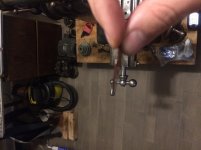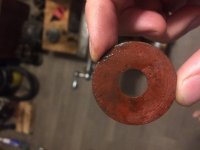wgambucci
Plastic
- Joined
- Nov 7, 2018
- Location
- Brooklyn, NY, USA
Hello- I recently bought an old Ames benchtop horizontal milling machine. It's the one with the overarm support described and pictured at the bottom of the page here:
Ames Milling Machine
When disassembling and cleaning the machine, I encountered red, nonmetallic thrust washers on the feed screws that allow everything turn very smoothly, even when the handwheels are snugged up tightly. Here's a link to a photo I took of one of the washers.
Imgur: The magic of the Internet
The one pictured is .040" thick with a wafer-like, sort of brittle feel, and perhaps a mildly abrasive texture.
Wondering if anybody can help me ID this material, as it seems to make a great thrust washer. It's very low-profile, and I'm interested in finding something similar to use on the cross slide and compound screws of my Logan lathe (which has some annoying end play in the slides related to the lack of thrust bearings).
After digging a bit online and comparing images I thought it might be some kind of phenolic wahser, but I'm not sure.
If phenolic, does anybody have a guess at what the base material might be, or if there is a modern day substitute for such a washer? Any info would be greatly appreciated.
I would love to avoid having to add needle roller bearings all over the place in my lathe slides when these red things seem to do the job perfectly on the Ames. On the other hand, if you think there's a reason to avoid using these, I'm all ears (eyes?).
Thanks!
Willie
Ames Milling Machine
When disassembling and cleaning the machine, I encountered red, nonmetallic thrust washers on the feed screws that allow everything turn very smoothly, even when the handwheels are snugged up tightly. Here's a link to a photo I took of one of the washers.
Imgur: The magic of the Internet
The one pictured is .040" thick with a wafer-like, sort of brittle feel, and perhaps a mildly abrasive texture.
Wondering if anybody can help me ID this material, as it seems to make a great thrust washer. It's very low-profile, and I'm interested in finding something similar to use on the cross slide and compound screws of my Logan lathe (which has some annoying end play in the slides related to the lack of thrust bearings).
After digging a bit online and comparing images I thought it might be some kind of phenolic wahser, but I'm not sure.
If phenolic, does anybody have a guess at what the base material might be, or if there is a modern day substitute for such a washer? Any info would be greatly appreciated.
I would love to avoid having to add needle roller bearings all over the place in my lathe slides when these red things seem to do the job perfectly on the Ames. On the other hand, if you think there's a reason to avoid using these, I'm all ears (eyes?).
Thanks!
Willie





